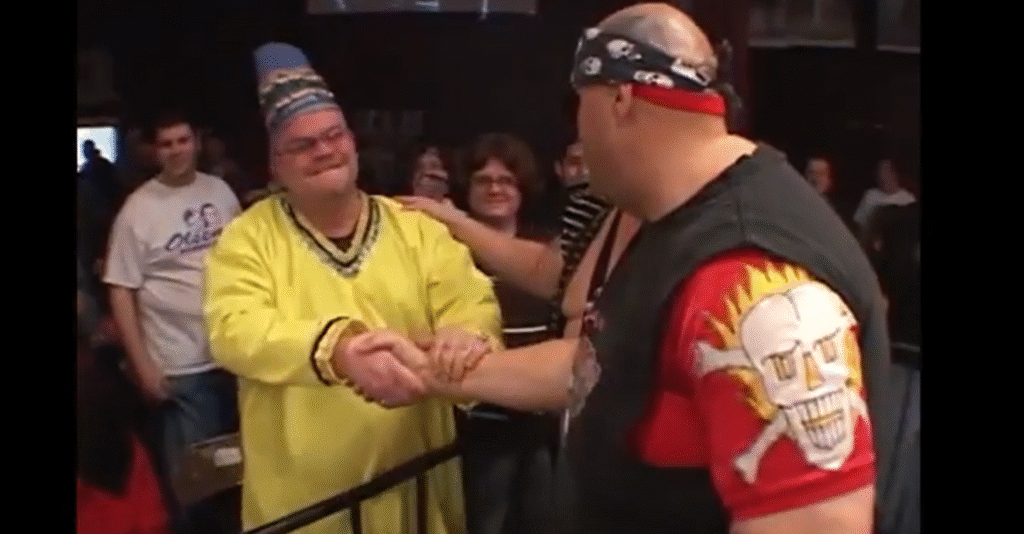Akeem’s tale exemplifies wrestling at its most experimental and theatrical, where reinvention was not only an option but also a requirement. He was born George Gray and came into the ring as a massive man with remarkably effective agility for his size. Despite weighing close to 450 pounds, fans who first saw him as Crusher Broomfield on the Carolina circuits saw an athlete who could move surprisingly quickly and land punishing splashes that electrified audiences.
By the early 1980s, he was wrestling in several states, including Florida and Texas, where his One Man Gang reputation quickly expanded. His appearance—complete with skull tattoos and a mohawk—made him remarkably reminiscent of the antagonists of the action movies that were then the dominant force in popular culture. Promoters found him especially useful in attracting fans who wanted to watch their hometown heroes defeat an invincible villain.
Credibility peaked during his tenure in the Universal Wrestling Federation when he won and retained the UWF Heavyweight Championship for six months. Among a sea of talent, Gray’s intensity was remarkable. Using his size and heel persona, he became the focal point of plots against well-known characters like Ted DiBiase and Hacksaw Jim Duggan. During this time, he demonstrated his ability to carry main-event matches, which significantly raised his profile nationally.
Akeem – Key Information
| Detail | Information |
|---|---|
| Real Name | George Gray |
| Ring Names | Akeem, One Man Gang, Crusher Broomfield, Crusher Gray |
| Born | February 12, 1960 – Chicago, Illinois, U.S. |
| Height | 6 ft 9 in (206 cm) |
| Weight | 450 lbs (204 kg) |
| Signature Move | 747 Splash |
| Debut | 1977 |
| Retired | 2009 |
| Major Promotions | WWF, WCW, ECW, UWF, WCCW |
| Championships | UWF World Heavyweight Champion, WCW U.S. Champion, WWC Hardcore Champion |
| Career Highlights | Part of “The Twin Towers” with Big Boss Man, feuded with Hulk Hogan, Randy Savage, Dusty Rhodes |
| Reference | https://www.wwe.com/superstars/akeem |

In 1987, One Man Gang felt like a threat the moment he joined WWF. His devastating 747 Splash became his trademark, and his early performances demonstrated a performer who was extremely effective at swiftly destroying opponents, solidifying his reputation as an almost unstoppable force. He was equally feared and admired by audiences, and his conflicts with Randy Savage and Hulk Hogan demonstrated how essential he had grown to be to WWF’s dramatic plots.
However, One Man Gang’s “rebirth” as Akeem, “The African Dream,” in 1988 marked the most significant change. Akeem danced and spoke in exaggerated tones as part of a staged ritual, depicting the metamorphosis in a vignette that caused controversy due to its stereotypical imagery. Despite being controversial, it was incredibly resilient in fan memory since it perfectly captured the extravagant style of WWF storytelling. The character is still brought up in discussions about wrestling’s audacious but frequently problematic artistic decisions even after several decades have passed.
Akeem became one half of a duo that fans remember clearly when he formed The Twin Towers with Big Boss Man. Their conflict with the Mega Powers, Randy Savage and Hulk Hogan, was at the heart of WWF’s most significant plot point at the time. There was a sense of urgency that permeated WrestleMania V after the startling scene of Hogan handcuffed to a ring post at Survivor Series 1988 while the Towers beat him. Akeem was central to these very successful storylines, which combined physical dominance with betrayal of the self.
Beyond his time with the WWF, Akeem demonstrated remarkable versatility. He proved that he could adapt to new environments for a long time in WCW by returning to his One Man Gang persona and winning the United States Championship. While his time in Puerto Rico highlighted his ability to interact with a variety of audiences, his tours of Japan demonstrated a wrestler capable of working with figures such as Giant Baba and Bruiser Brody. He even had brief stints in ECW, where fans who were looking for intensity responded to his size and brutality.
Akeem’s ability to transcend wrestling eras is what makes his legacy so evident. He adopted the gritty styles of WCW and ECW after representing the larger-than-life villains of the territory days and moving into the WWF boom, which prioritized entertainment. His career path is remarkably similar to that of artists who have reinvented themselves and remained relevant over the years, such as Kane or Big Show.
His story carries both success and adversity outside of the ring. Gray experienced health issues after retirement, such as a heart attack and chronic back issues. Even wrestling giants face hardships away from the spotlight, as evidenced by the destruction of his home caused by the 2016 Louisiana floods. A moving reminder of the human side of an athlete once praised in arenas was his public call for support. As evidenced by the rallying of fans, the relationship created during those years of performance was remarkably resilient.
When considering his impact, it becomes clear how wrestling employed figures like Akeem to challenge entertainment conventions, reflect societal trends, and spark debate. Even though there is disagreement over the gimmick itself, his performances were unquestionably impactful and served as a reminder to viewers of why they enjoyed wrestling’s unpredictable nature. His narrative demonstrates how, despite the potential risks, reinvention can be a very powerful tool for preserving a performer’s reputation and establishing them in popular culture.

